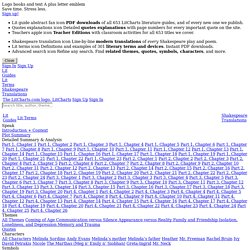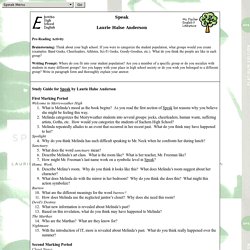

Speak - Mrs. Pilgreen's English I Website. 1.

For the Picasso assignment, print a copy of the Art Response sheet below. 2. Next, click on the link to the Art History Archive article on Pablo Picasso. You will find several pictures of artwork by Picasso. Choose one that interests you. Free Study Guide for Speak by Laurie Halse Anderson. Speak Study Guide from LitCharts. Laurie Halse Anderson has written many other books about contemporary teenage issues; one of the most prominent is Wintergirls (2009), which deals with the sensitive topic of eating disorders as thoughtfully and poignantly as Speak discusses rape and depression.

Maya Angelou’s I Know Why the Caged Bird Sings (1969) also deals with issues of rape, disenfranchisement, and coming of age as a woman. J.D. Salinger’s Catcher in the Rye (1951) represents the original dark coming-of-age story, while Sherman Alexie’s The Absolutely True Diary of a Part Time Indian (2007), which depicts a young boy growing up on a reservation, similarly focuses on the narrative of a teenager trying to grow up under difficult circumstances. The Book Thief (2007), by Marcus Zuzak, also focuses on a female protagonist whose internal strength helps her to mature in the face of life’s challenges; although she lives in Nazi Germany, not upstate New York.
Speak Study Guide. Speak Study Guide. Eng1d speak novel study. Opt In. Shmoop's privacy policy is designed to help you understand what information we collect from you and how that information is used by Shmoop and its directly related domains (collectively, "Shmoop", "we", "us" or the "Site").

Your trust and confidence are essential to our success. Shmoop respects your privacy and will not sell or share your personally identifiable information with another party without your expressed consent, other than as described in "Exceptions to Sharing Personally Identifiable Information" below. Your use of the Shmoop website constitutes your consent to this Privacy Policy and Shmoop's Terms of Use. This Privacy Policy does not cover: Information collected by third-party websites linked from Shmoop Information collected off-line Shmoop may revise this Privacy Policy from time to time to accurately reflect the Shmoop Site and Shmoop services in general. Information We Collect We collect two types of information from you: Registration Other Voluntarily Submitted Information.
Book Summary. Melinda Sordino begins her freshman year at Merryweather High School in Syracuse, New York, with a heavy secret weighing on her.

Over the summer, she and her friends went to a party and Melinda ended up calling the police, causing her friends and everyone at the party to socially reject her. Melinda's only friend is Heather, a new student, who tries to get Melinda involved in her schemes to gain popularity. Melinda, however, is not interested in gaining popularity and spends much of her time in an abandoned janitor's closet at school.
She has stolen some late passes, so she uses the closet as a hideout to avoid teachers she dislikes and painful interactions with her former friends. Her only solace at school is art class, where she is working on a year-long project to create various interpretations of a tree. Study Guide for Speak by Laurie Halse Anderson. Authors use figurative language to create a picture in the readers’ minds.

Most of the time, the author is comparing what is really happening with something people are familiar with, allowing the reader to make a connection with what is happening in the novel. Figurative language also allows the author to express in more a powerful way what is occurring in the novel. Some literary elements that are used to create figurative language are: Simile: a comparison between two unlike things using the words like or as. Metaphor: a comparison between two unlike things without using the words like or as. Personification: giving human qualities to non-living objects. Activity One: Read the examples of figurative language from Speak listed below. 1. ____ Words climb up my throat. 2. ____ I dive into the stream of fourth-period lunch students and swim down the hall to the cafeteria. 3. ____ I have been dropped like a hot Pop Tart on a cold kitchen floor.